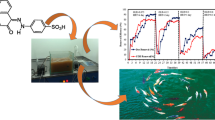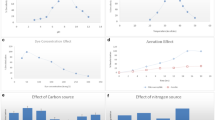Abstract
The main objective of this study was to investigate the efficiency of biological treatment of azo dye-containing wastewater with a sequencing batch reactor system, followed by ultrafiltration. The performance of the system was quantified by measuring the chemical oxygen demand and azo dye concentration. The biodegradation was carried out under combined alternating anaerobic and aerobic conditions with Nylosan Yellow E2RL SGR as a model azo dye contaminant. The bioprocess revealed a maximal reduction in chemical oxygen demand and dye removal efficiency of 91 and 85%, respectively. After ultrafiltration of effluent from the biological treatment, the efficiency increased to 94% for chemical oxygen demand and to 97% for the azo dye decolourisation. Samples of activated sludge from the bioprocess were collected for microbial characterisation. Bacteria and fungi were isolated and identified by 16S rRNA gene and ITS1-5.8S rDNA-ITS2 sequence analysis, respectively. Serratia marcescens and Klebsiella oxytoca were the most common bacteria with the highest number present during the aerobic and anaerobic phases of the bioprocess. In addition, a high number of Elizabethkingia miricola, Morganella morganii, Comamonas testosteroni, Trichosporon sp. and Galactomyces sp. were detected. Taken together, our results demonstrated that the sequencing batch reactor system combined with ultrafiltration is an efficient technique for treatment of wastewater containing azo dye. Moreover, the ultrafiltration effectively removes the microbiota from the final effluent resulting in stable product water.





Similar content being viewed by others
References
Al-Amrani WA, Lim P-E, Seng C-E, Wan Ngah WS (2014) Factors affecting bio-decolorization of azo dyes and COD removal in anoxic–aerobic REACT operated sequencing batch reactor. J Taiwan Inst Chem Eng 45:609–616
APHA (2005) Standard Methods for the Examination of Water and Wastewater, 21st edn. American Public Health Association, Washington DC, USA
Asadi A, Zinatizadeh AAL, Hasnain Isa M (2012) Performance of intermittently aerated up-flow sludge bed reactor and sequencing batch reactor treating industrial estate wastewater: a comparative study. Bioresour Technol 123:495–506
Ayed L, Mahdhi A, Cheref A, Bakhrouf A (2011) Decolorization and degradation of azo dye Methyl Red by an isolated Sphingomonas paucimobilis: biotoxicity and metabolites characterization. Desalination 274:272–277
Barragan BE, Costa C, Marquez CM (2007) Biodegradation of azo dyes by bacteria inoculated on solid media. Dyes Pigm 75:73–81
Brás R, Ferra MIA, Pinheiro HM, Gonçalves IC (2001) Batch tests for assessing decolourisation of azo dyes by methanogenic and mixed cultures. J Biotechnol 89:155–162
Chen H (2006) Recent advances in azo dye degrading enzyme research. Curr Protein Pept Sci 7:101–111
Chengalroyen MD, Dabbs ER (2013) The microbial degradation of azo dyes: minireview. World J Microbiol Biotechnol 29:389–399
Çinar Ö, Yaşar S, Kertmen M, Demiröz K, Yigit NÖ, Kitis M (2008) Effect of cycle time on biodegradation of azo dye in sequencing batch reactor. Process Saf Environ Prot 86:455–460
Cruz A, Buitron G (2001) Biodegradation of disperse blue 79 using sequenced anaerobic/aerobic biofilters. Water Sci Technol 44:159–166
da Silva M, Firmino P, de Sousa M, dos Santos A (2012) Sequential anaerobic/aerobic treatment of dye—containing wastewaters: colour and COD removals and ecotoxicity tests. Appl Biochem Biotechnol 166:1057–1069
Evangelista-Barreto NS, Albuquerque CD, Vieira RHSF, Campos-Takaki GM (2009) Cometabolic Decolorization of the Reactive Azo Dye Orange II by Geobacillus stearothermophilus UCP 986. Text Res J 79:1266–1273
Hakimelahi M, Moghaddam M, Hashemi S (2012) Biological treatment of wastewater containing an azo dye using mixed culture in alternating anaerobic/aerobic sequencing batch reactors. Biotechnol Bioprocess Eng 17:875–880
Hao OJ, Kim H, Chiang P-C (2000) Decolorization of wastewater. Crit Rev Environ Sci Technol 30:449–505
Hosseini Koupaie E, Alavi Moghaddam MR, Hashemi SH (2011) Post-treatment of anaerobically degraded azo dye Acid Red 18 using aerobic moving bed biofilm process: enhanced removal of aromatic amines. J Hazard Mater 195:147–154
Jadhav JP, Kalyani DC, Telke AA, Phugare SS, Govindwar SP (2010) Evaluation of the efficacy of a bacterial consortium for the removal of color, reduction of heavy metals, and toxicity from textile dye effluent. Bioresour Technol 101:165–173
Johnstrup M, Kumar N, Murto M, Mattiasson B (2011) Sequential anaerobic–aerobic treatment of azo dyes: decolourisation and amine degradability. Desalination 280:339–346
Kao CM, Liu JK, Lou HR, Lin CS, Chen SC (2003) Biotransformation of cyanide to methane and ammonia by Klebsiella oxytoca. Chemosphere 50:1055–1061
Kapdan IK, Oztekin R (2006) The effect of hydraulic residence time and initial COD concentration on color and COD removal performance of the anaerobic–aerobic SBR system. J Hazard Mater 136:896–901
Khehra MS, Saini HS, Sharma DK, Chadha BS, Chimni SS (2006) Biodegradation of azo dye C.I. Acid Red 88 by an anoxic–aerobic sequential bioreactor. Dyes Pigm 70:1–7
Kitts CL, Cunningham DP, Unkefer PJ (1994) Isolation of three hexahydro-1,3,5-trinitro-1,3,5-triazine-degrading species of the family Enterobacteriaceae from nitramine explosive-contaminated soil. Appl Environ Microbiol 60:4608–4611
Korenak J, Petrinić I, Čurlin M, Petrovič R, DE Langhe P, Coenen S, Germ M (2013) Overview of the Erasme project entitled “high-efficient and cost-effective air-lift MBR for water reuse in textile finishing. In: Penava Ž (ed) 6th international scientific-professional symposium textile science and economy 2013 Zagreb, Croatia. pp 1–4
Libra JA, Borchert M, Vigelahn L, Storm T (2004) Two stage biological treatment of a diazo reactive textile dye and the fate of the dye metabolites. Chemosphere 56:167–180
Lourenço ND, Novais JM, Pinheiro HM (2000) Reactive textile dye colour removal in a sequencing batch reactor. Water Sci Technol 42:321–328
Lourenço ND, Novais JM, Pinheiro HM (2001) Effect of some operational parameters on textile dye biodegradation in a sequential batch reactor. J Biotechnol 89:163–174
Ong S-A, Toorisaka E, Hirata M, Hano T (2005) Decolorization of azo dye (Orange II) in a sequential UASB–SBR system. Sep Purif Technol 42:297–302
Otero M, Rozada F, Calvo LF, García AI, Morán A (2003) Kinetic and equilibrium modelling of the methylene blue removal from solution by adsorbent materials produced from sewage sludges. Biochem Eng J 15:59–68
Öztekin R (2004) Colour removal from textile wastewater in sequencing batch reactor. Dokuz Eylül University, Izmır
Padmanaban VC, Geed SR, Achary A, Singh RS (2016) Kinetic studies on degradation of Reactive Red 120 dye in immobilized packed bed reactor by Bacillus cohnii RAPT1. Bioresour Technol 213:39–43
Panswad T, Techovanich A, Anotai J (2001) Comparison of dye wastewater treatment by normal and anoxic + anaerobic/aerobic SBR activated sludge processes. Water Sci Technol 43:355–362
Phugare SS, Kalyani DC, Surwase SN, Jadhav JP (2011) Ecofriendly degradation, decolorization and detoxification of textile effluent by a developed bacterial consortium. Ecotoxicol Environ Saf 74:1288–1296
Popli S, Patel UD (2015) Destruction of azo dyes by anaerobic–aerobic sequential biological treatment: a review. Int J Environ Sci Technol 12:405–420
Rajaguru P, Kalaiselvi K, Palanivel M, Subburam V (2000) Biodegradation of azo dyes in a sequential anaerobic–aerobic system. Appl Microbiol Biotechnol 54:268–273
Sani RK, Banerjee UC (1999) Decolorization of triphenylmethane dyes and textile and dye-stuff effluent by Kurthia sp. Enzyme Microb Technol 24:433–437
Saratale RG, Saratale GD, Chang JS, Govindwar SP (2011) Bacterial decolorization and degradation of azo dyes: a review. J Taiwan Inst Chem Eng 42:138–157
Sirianuntapiboon S, Srisornsak P (2007) Removal of disperse dyes from textile wastewater using bio-sludge. Bioresour Technol 98:1057–1066
Slapšak N, Cleenwerck I, de Vos P, Trček J (2013) Gluconacetobacter maltaceti, a novel vinegar producing acetic acid bacterium. Syst Appl Microbiol 36:17–21
Solís M, Solís A, Pérez HI, Manjarrez N, Flores M (2012) Microbial decolouration of azo dyes: a review. Process Biochem 47:1723–1748
Spagni A, Grilli S, Casu S, Mattioli D (2010) Treatment of a simulated textile wastewater containing the azo-dye Reactive Orange 16 in an anaerobic-biofilm anoxic–aerobic membrane bioreactor. Int Biodeterior Biodegradation 64:676–681
Sponza DT, Işik M (2002) Decolorization and azo dye degradation by anaerobic/aerobic sequential process. Enzyme Microb Technol 31:102–110
Sponza DT, IŞıK M (2005) Reactor performances and fate of aromatic amines through decolorization of Direct Black 38 dye under anaerobic/aerobic sequentials. Process Biochem 40:35–44
Štornik A, Skok B, Trček J (2016) Comparison of cultivable acetic acid bacterial microbiota in organic and conventional apple cider vinegar. Food Technol Biotechnol 54:113–119
Wang Y, Mu Y, Zhao Q-B, Yu H-Q (2006) Isotherms, kinetics and thermodynamics of dye biosorption by anaerobic sludge. Sep Purif Technol 50:1–7
Wong PK, Yuen PY (1996) Decolorization and biodegradation of methyl red by Klebsiella pneumoniae RS-13. Water Res 30:1736–1744
Wu Y, Li T, Yang L (2012) Mechanisms of removing pollutants from aqueous solutions by microorganisms and their aggregates: a review. Bioresour Technol 107:10–18
Acknowledgements
The study was financed within the EraSME Project titled “High-efficient and cost-effective air lift MBR for water reuse in textile finishing”, Project No. 430-26/2010/40.
Author information
Authors and Affiliations
Corresponding author
Additional information
Editorial responsibility: M. Abbaspour.
Rights and permissions
About this article
Cite this article
Korenak, J., Ploder, J., Trček, J. et al. Decolourisations and biodegradations of model azo dye solutions using a sequence batch reactor, followed by ultrafiltration. Int. J. Environ. Sci. Technol. 15, 483–492 (2018). https://doi.org/10.1007/s13762-017-1406-z
Received:
Revised:
Accepted:
Published:
Issue Date:
DOI: https://doi.org/10.1007/s13762-017-1406-z




